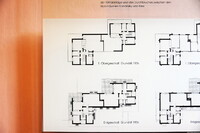| dc.coverage.spatial | Site: Dessau, Saxony-Anhalt, Germany | en_US |
| dc.coverage.temporal | display ca. 2009 (exhibition) | en_US |
| dc.creator | Gropius, Walter | en_US |
| dc.date.accessioned | 2013-07-29T16:46:54Z | |
| dc.date.available | 2013-07-29T16:46:54Z | |
| dc.date.issued | 2013-07-29 | |
| dc.identifier | 227199 | en_US |
| dc.identifier.other | archrefid: 2192 | en_US |
| dc.identifier.uri | http://hdl.handle.net/1721.3/134982 | |
| dc.description | Plan, depicting evolution of the construction of Wassily Kandinsky and Paul Klee semidetached house, detail (drawing found on site); Drawings displayed at the Kandinsky/Klee house, which is open to the public. In 1925, the city of Dessau commissioned Walter Gropius with the construction of three semidetached houses for the Bauhaus masters and a detached house for its director. The plot lies in a small pine-tree wood where Ebertallee stands today. In 1926, Gropius and the Bauhaus masters László Moholy-Nagy and Lyonel Feininger, Georg Muche and Oskar Schlemmer as well as Wassily Kandinsky and Paul Klee were able to move in with their families. With this ensemble of buildings, Gropius aimed, using industrially prefabricated and simple “building block” construction elements, to put the principles of efficient construction into practice--both in relation to the architecture and the building process itself. The semidetached houses are essentially all the same: Each half of the house shares the same floor plan, albeit mirrored and rotated by 90°. Only on the second floor do the halves of the houses differ; the western section always features two additional rooms. Source: Bauhaus Dessau [website]; http://www.bauhaus-dessau.de/ (accessed 5/8/2011) | en_US |
| dc.rights | © Scott Gilchrist, Archivision, Inc. | en_US |
| dc.subject | architecture | en_US |
| dc.subject | Housing | en_US |
| dc.subject | Restoration and conservation | en_US |
| dc.subject | Twentieth century | en_US |
| dc.subject | Bauhaus | en_US |
| dc.subject | Modernist | en_US |
| dc.title | Masters' Houses Ensemble: Drawings | en_US |
| dc.type | image | en_US |
| dc.rights.access | Licensed for educational and research use by the MIT community only | en_US |
| dc.identifier.vendorcode | 1A1-GW-MH-AA-A2 | en_US |
| vra.culturalContext | German | en_US |
| vra.technique | | en_US |
| vra.worktype | site plan | en_US |
| dc.contributor.display | after Walter Gropius (American architect, 1883-1969) | en_US |


